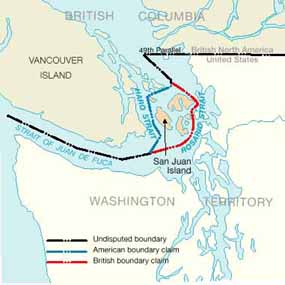Did you know that the United States and Great Britain narrowly averted a third bloody war with each other in 1859? In a crisis known as The Pig War on San Juan Island in what is today northwest Washington State, anger over a shot pig and a long-simmering territorial dispute nearly led to untold deaths, calamity, and economic losses.
Thankfully, cooler heads prevailed and the pig was the only casualty in this lesson on how peace can be achieved. Instead of attacking one another, the Americans and British established a peaceful joint occupation on San Juan Island while the dispute could be decided by an international arbiter, who happened to be Kaiser Wilhelm I of Germany. Yet how many students–and even well-educated adults–know this story? Nearly every student learns of the bloody conflicts in our history, in which war is often glorified–or at least justified–as an appropriate means of resolving disputes, yet far too few learn about the true costs of war and how throughout history equally courageous men and women have successfully fought to prevent it. These alternative stories–like all education–are even more powerful if they are connected to the places in which they live, in this case the Pacific Northwest and British Columbia.
From learning about an episode such as this one–ideally through a visit to the place, or at least some kind of virtual field trip, many students would no doubt be inspired to learn more about the history of the time. This might include investigating the role of the governor of the Oregon Territory at the time or how Native Americans might have been impacted by the political maneuverings. By inspiring students with stories and investigations that connect with real places close to home, teachers can dramatically increase student engagement and learning. If done right, this can even help teach essential concepts such as how to resolve conflicts peacefully.

